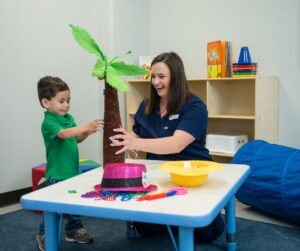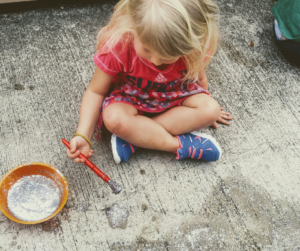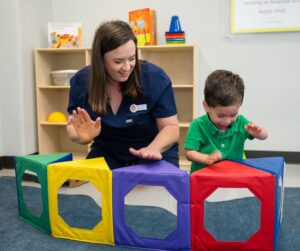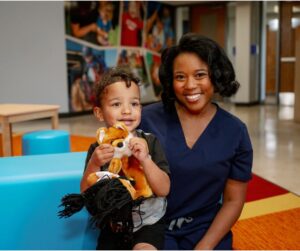We commonly hear the phrases “sensory issues” or “sensory needs” buzzing around today. For instance, maybe you have heard others discussing this topic or have questioned if it is relevant to your own sweet kiddo. If the latter, you may have asked “Is this truly a sensory issue or is it a behavioral issue? What are the signs I should be looking for? If my child has sensory processing issues or needs, what can I do to help? Are there activities that are more sensory safe that I should be providing my child?
This blog seeks to describe sensory integration and its common terminology. Furthermore, it will illustrate how sensory responses differ from behavioral reactions and explain the seven distinct categories of sensory input. Additionally, it will provide common behavioral signs associated with children who avoid and seek input within each of the senses. Lastly, it will supply safe and easy activities for each type of input to use at home.
What is sensory integration?
Sensory integration in early childhood is an important process that helps children develop their sensory system (the 7 senses) and respond appropriately to the world around them. During early childhood, children’s brains are rapidly developing, and they learn how to process and respond to different sensory information through play and exploration.
As parents, you can support your child’s sensory integration by providing opportunities for sensory play and exploration. This can include activities such as playing with different textures, engaging in messy play, and interacting with toys that make noise or light up. Consequently, by providing these experiences, you can help your child develop their sensory processing skills, which can improve their attention, communication, social interaction, and motor coordination.
 What is the difference between behavioral reactions and sensory responses?
What is the difference between behavioral reactions and sensory responses?
Behavioral reactions are when a child reacts because they didn’t get what they wanted or expected. For example, they may be seeking attention or trying to get a reaction from someone because a demand wasn’t met. They are aware of their surroundings and their behavior is meant to influence a person or situation. The behavior usually stops once they get what they want.
On the other hand, sensory responses or meltdowns are when a child is overwhelmed by sensory input. This means that they are not reacting to a demand or desire not being met, but rather their body is responding biologically to certain sensations. They are not in control of themselves and may not be aware of their surroundings or others around them. These reactions last longer and take a longer time to recover from. It’s important to note that this type of reaction is not a choice, but rather a biological response to either “Fight,” “Flight,” or “Freeze.”
What factors influence a child’s reaction and sensory processing?
There are two factors that influence a child’s reaction and sensory processing to each of the 7 senses: Intensity & Reactivity
Intensity is like water from a hose. For instance, children receiving low intensity input are only receiving drips from the hose. Conversely, children receiving high intensity input receive blasting water from the hose.
Reactivity is how the child responds to input. In fact, high responsivity means the child is very uncomfortable with the input being given or tries to avoid it completely. On the other hand, low responsivity means the child may not notice the input being given or may seek ways to get more input.
 What are the different types of sensory behaviors?
What are the different types of sensory behaviors?
Sensory sensitive behavior involves low intensity input and over-responsivity, such as sensitivity to touch, sights, or sounds.
Low sensory registration or inattentive behavior involves low intensity input and low responsivity, such as difficulty maintaining attention to tasks.
Sensation avoidance involves high intensity input and high responsivity, such as not wanting to interact with new people, places, or activities.
Sensation seeking behavior involves high intensity input and low responsivity, such as seeking stimulation, clumsiness due to poor body awareness.
 What are the 7 Senses?
What are the 7 Senses?
- Sight (Visual)
- Hearing (Auditory)
- Smell (Olfactory)
- Taste (Gustatory)
- Touch (Tactile)
- Vestibular (Movement/Balance): gives us information about where our head & body are in space, helping us stay upright while sitting, standing, and walking,
- Proprioception (Body Position Awareness): tells us where our body parts are relative to each other, and gives us information about how much force to use.
If you notice that your child is having difficulty with sensory processing and sensory integration, such as oversensitivity or undersensitivity to certain stimuli, difficulty with coordination and motor skills, or difficulty with attention and social interaction, it’s important to seek early intervention and consider sensory integration therapy. With early intervention and support, you can help your child develop healthy sensory processing skills and improve their functional abilities.
Here are some sensory processing warning signs to look for with each of the 7 senses:
It is important to note that many children possess a mix of responsiveness across the senses.
Visual sensory processing (sight)
Avoidant: Sensitive to light; distracted by visual stimuli; squinting; rubbing of eyes; complains of headache
Seeking: prefers bright, reflective, and shiny objects; easily distracted by spinning, flashing, or moving lights; insists on clothes with specifics shapes, colors, or patterns; craves screen time
Auditory sensory processing (hearing)
Avoidant: easily overwhelmed by noise; covers ears in response to sound; screams in response to sound; runs out of loud rooms or refuses to go into busy environments
Seeking: speaks loudly; seems to yell frequently; makes repetitive sounds like tapping, clicking, clapping, or humming; has difficulty completing tasks without making noise; seeks out busy locations.
Olfactory sensory processing (smell)
Avoidant: strong negative reactions to smells unnoticeable to others; refuses to try foods or be in the same room as certain foods; aversion to scented objects
Seeking: craves strong, specific, or unusual scents; becomes unusually attached to an object with a particular scent
Gustatory & Oral-Motor sensory processing (taste)
Avoidant: frequent gagging, choking, or vomiting in response to certain foods; avoids certain flavors, temperatures, and textures of food; lets food drop from the mouth
Seeking: puts everything in the mouth; chewing clothing; chewing tools/utensil; frequently licks non-edible objects
Tactile sensory processing (touch)
Avoidant: refuses to wear specific clothing or fabrics; avoids certain food textures; avoids getting hands dirty or participating in messy play; avoids walking on surfaces, such as grass; demonstrates a greater than normal resistance to grooming/hygiene routines; avoids being touched
Seeking: constantly touches everything; craves prolonged hugs and kisses; prefers engaging in messy play; tends to play roughly.
Vestibular sensory processing (movement / balance)
Avoidant: demonstrates a fear of feet leaving the ground; avoids play equipment such as swings or climbing structures; does not like to lean backward; becomes anxious when lifted; prefers sedentary activities; may experience difficulty with travel, such as riding in the car.
Seeking: appears to be constantly in motion; may frequently climb and jump on furniture; crave being upside down and spinning; movements may be fast or unintentionally rough; have difficulty staying seated
Proprioceptive sensory processing (body position awareness)
Avoidant: avoids physical contact with others; refuses to play on swings or playground equipment; inability to accurately assess risk such as believing they can fall through a small hole; becomes anxious when someone enters their personal space; becomes anxious in crowded locations; avoids physical play
Seeking: appears to be clumsy; often bumps or crashes into people, walls, furniture; tends to stand in close proximity to others; often touches others without permission; craves to be hugged or held; craves physical pressure; enjoys rough and tumble play
 What can a Parent / Guardian do?
What can a Parent / Guardian do?
To help your child overcome their aversion to certain sensory experiences and become more engaged, there are several things you can do as a parent. Gradually introducing more activities that involve the sensory area in question is one approach that can be effective. Additionally, providing your child with plenty of opportunities to participate in sensory activities they enjoy or don’t typically register can also be helpful. As a parent, you can also provide sensory-safe activities that cater to your child’s specific needs. These activities can help children who are under-responsive to sensory input by providing the necessary input to increase their focus, attention, and body awareness, which can support their overall development.
The following list of Sensory Safe Activities for Children provides age-appropriate activity ideas for each of the 7 senses. This is not an exhaustive list, but rather intended to serve as a tool to foster creativity. Click the link to skip to the specific age group:
- 0-3 months
- 3-9 months
- 9-18 months
- 18-36 months
Sensory Safe Activities for Children 0-3 months
Here are some sensory safe activities for children aged 0-3 months that can help them learn, development their sensory processing abilities, and have fun while being safe.
Visual (Sight)
- High contrast toys (red, black, white)
- Black & white patterns on fabric, books or flash cards
- Faces
- Change scenery
- Mirror play
Auditory (Hearing)
- Talk in silly voices
- Sing songs
- Play music
- Rattle play
Olfactory (Smell)
- Scented baby products
- Smell foods
- Take turns with blanky or stuffed animal
Tactile (Touch)
- Skin to skin contact
- Wrapping in different texture blankets
- Different textured clothing
- Fabric/texture squares
- Water play
Vestibular (Movement/Balance)
- Swinging
- Rocking
- Try different positions
- Bouncing in arms
- Walking in stroller
Proprioceptive (Body Position Awareness)
- Tummy time
- Massage
- Swaddle
- Baby stretches
- Songs: “Head, shoulders, knees & toes” & “Patty-cake”
Sensory Safe Activities for Children 3-9 months
Here are some sensory safe activities for children aged 3-9 months that can help them learn, development their sensory processing abilities, and have fun while being safe.
Visual (Sight)
- Books & flash cards
- Visual sensory bottles
- Silly facial expressions
- Mirror play
- Bubbles
Auditory (Hearing)
- Talk in silly voices
- Sing songs
- Play music
- Noisy toy/instrument play
- Environment sounds
Olfactory (Smell)
- Different scented baby products
- Exposure to scents of food cooking
Gustatory (Taste)
- If not concerned about allergies, consider puree play with vegetables then fruits when exhibiting head control
Tactile (Touch)
- Exploration of textured materials, toys, baby safe household objects
- Textured books
- Run smooth, bumpy, spikey, hard, squishy, crinkly, shiny or furry materials over hands, arms, feet, face, belly, back
- Bath play
- Different textures of clothes & blankets
Vestibular (Movement/Balance)
- Swinging
- Rocking
- Place in different positions
- Bouncing in arms
- Walking in stroller
Proprioceptive (Body Position Awareness)
- Tummy time
- Massage
- Baby stretches
- Songs: “Head, shoulders,” “Patty-cake,” “Row, Row your boat,” “I’m a little teapot”
- Placement objects of interest to promote reaching & kicking
Sensory Safe Activities for children 9-18 months
Here are some sensory safe activities for children aged 9-18 months that can help them learn, development their sensory processing abilities, and have fun while being safe.
Visual (Sight)
- Point out and label objects
- Turning pages of board book
- Blowing bubbles, feathers, etc.
- Dropping pom-poms, plastic grass (objects of different texture)
- Cause and effect play (rolling, dropping, pouring objects)
- Searching for objects – hide and seek or digging for objects in bin
Auditory (Hearing)
- Banging toys (wooden spoons on pots)
- Describe you actions while dressing, feeding, bathing, etc.
- Sing songs, listen to music
- Nature walk describe sounds
- Rattles, shakers, rain sticks
Olfactory (Smell)
- Scent jars
- Have baby in a highchair while cooking
- Lotions with different scents
- Make playdoh with different scents
Gustatory (Taste)
- Touch, pour, pull, stir foods of different flavors & textures (noodles, jello, puree, crumbled, crunchy, savory, salty, sour, sweet, spicy, cold)
- Offer foods to explore in cupcake tin or ice cube tray
Tactile (Touch)
- Sensory bins (beans, rice, seeds, sand, crumbled crackers, noodles, jello, etc.)
- Velcro play
- Tactile bin or board – sponges, fabrics, buttons, sandpaper, fur, ribbons, pipe cleaners
- Water play
- Ziploc play (slime, lotions, powder, gel, shaving cream, etc.)
- Board books with textures
Vestibular (Movement/Balance)
- Bouncing up and down, rocking back and forth
- Swinging
- Blanket play (rocking)
- Twirling, “flying”
- Lie down and place baby on your shins or tummy for bouncing
- Baby slide
Proprioceptive (Body Position Awareness)
- Push toys to practice walking
- Toys that require different amounts of force
- Songs with body movements
- Massage – Handheld massager
- Bouncing & jumping (trampoline)
- Stomping/marching
- Sing songs with body motions
Sensory Safe Activities for Children 18-36 months
Here are some sensory safe activities for children aged 18-36 months that can help them learn, development their sensory processing abilities, and have fun while being safe.
Visual (Sight)
- Pattern play (tiles, blocks, sticks and stones)
- Roll small objects (cars) down paper towel tubes or ramps
- Searching for objects inn books
- Hide and seek (people & objects)
- Digging for objects in bin
- Color mixing
- Color matching
- Color sorting
- Balloon play
- Bubble play
- Dropping feathers, pom-poms, plastic grass, etc.
- Mirror play
Auditory (Hearing)
- Homemade instruments and shakers (rubber bands, tin cans, bells, boxes, plastic bottles)
- Sounds with balloons
- Using different voices
- Sing songs and listen to music
- Listen for sounds on nature walk
Olfactory (Smell)
- Scent jars – food, oils, spices, lotions
- Play with scented “orbies”
- Play with scented playdoh
- Draw with scented markers
- Play with scented stickers
- Cooking
Gustatory (Taste)
- Taste talk (color, texture, size, taste)
- Food play on tray
- Cooking
- Taste test foods in cupcake tin/ice cube tray
- Sort flavors (savory, salty, sour, sweet, spicy, bitter)
- Spice or condiment sampling on foods
Oral Motor Input – can also assist with concentration and reduce anxiety
- Blow bubbles
- Blow bubbles with a straw
- Drink thick liquid through straw (milkshake, yogurt)
- Blow harmonica
- Crunchy foods
- Spicy foods
- Tied t-shirt necklace
- Vibrating toothbrush
Tactile (Touch)
- Sensory bin (rice, oats, beans, cotton balls, etc.) Add items (toys, playing cards, blocks, scoops, cups, etc.)
- Fun with ice (add food dye for painting)
- Tactile experiences (finger paint, shaving creams, water, oatmeal, noodles, gel, etc.)
- Dressing dolls and faster boards
- Stacking blocks, cups
- Stringing objects on pipe cleaner or lacing string
- Bath play
- Peeling painter’s tape, stickers
Vestibular (Movement/Balance)
- Bending to pick up objects
- Songs: Head, shoulder, knees & toes
- Swinging
- Rocking horse
- Slides
- Merry go round; sit & spin
- Jumping & bouncing (trampoline, pillows, jumping jacks)
- Rolling
- Marching or running in place
- Keeping the beat (rhythm)
- Movement while sitting, lying, or being held
- dancing
- airplane on feet
- rolling on exercise ball
Proprioceptive (Body Position Awareness)
- Snuggle under pillows, cushions, bean bag, blankets (never cover face)
- Snuggle in pillowcase or body sock
- Massage – Handheld massager
- Pushing cart at the store or heavy objects (weighted box)
- Carry heavy objects (water bottles, weighted backpack, empty dishwasher)
- Bouncing & jumping (trampoline)
- Climbing (jungle gym)
- Obstacle course
- Hanging from bars
- Stomping/marching
- Kicking balls
- Wheelbarrow walking (holding feet)
- Pushing on scooter
- Crawling/crab walking
- Raking, digging in the yard
- Give specific locations: “Run to the wall and back,” etc.
- Chewing sticky foods, gum
- Drinking through straw
- Squeezing (putty, stress ball)
- Stretching, pulling apart, pushing together objects
- Push ups
- Jumping jacks
- Yoga poses
- Dig, rake, shovel
- Pull rope on doorknob, tree, etc.
- Hugs, squeezes, squishes with pillow
- Joint compressions
- Sit on wobbly cushion
- “Steam roll” ball over body
- Sitting in tight space/tent/fort
- Sing songs with body motions
- Chew toys
 Brighton Center’s Early Childhood Intervention (ECI) program for children ages 0-2 and 3-5 is one of 45 programs the State of Texas contracts. ECI’s goal is to quickly identify delays and implement services to minimize impairments and maximize the child’s skills. If you are a parent or guardian of a child age birth to 36 months that needs to be evaluated, submit an inquiry form and we will get back to you immediately.
Brighton Center’s Early Childhood Intervention (ECI) program for children ages 0-2 and 3-5 is one of 45 programs the State of Texas contracts. ECI’s goal is to quickly identify delays and implement services to minimize impairments and maximize the child’s skills. If you are a parent or guardian of a child age birth to 36 months that needs to be evaluated, submit an inquiry form and we will get back to you immediately.















